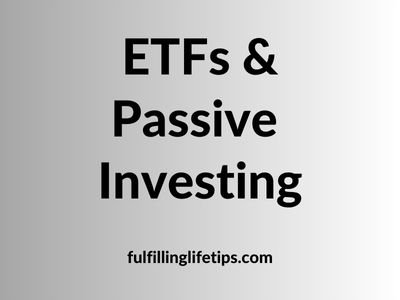Exchange-traded funds (ETFs) and passive investing have become increasingly popular among investors as a way to gain exposure to a diversified portfolio of assets at a low cost.
ETFs are a type of investment fund that trade on an exchange, similar to a stock. They typically track an index or a basket of assets, and their performance is designed to closely match that of the underlying index such as the S&P 500 or assets.
This passive investing approach has become increasingly popular over the years, as many investors have come to realize that actively managed funds often fail to beat their benchmarks over the long term.

What is Passive Investing?
Passive investing is an investment strategy that seeks to track the performance of a benchmark or index, rather than trying to outperform it. The goal is to achieve market returns at a low cost, without trying to time the market or pick individual stocks. This approach is based on the belief that over the long term, markets are efficient and that it’s difficult to consistently beat the market.
What are ETFs?
ETFs are a type of investment fund that trade on an exchange, similar to a stock. They are designed to track an index or a basket of assets, and their performance is intended to closely match that of the underlying assets.
ETFs can invest in a variety of assets, including stocks, bonds, commodities, and currencies. They are generally considered to be a cost-effective way to gain exposure to a diversified portfolio of assets, as they typically have lower expense ratios compared to actively managed mutual funds.
Advantages of ETFs and Passive Investing
- Low Costs: ETFs are generally considered to be a cost-effective way to invest, as they typically have lower expense ratios compared to actively managed mutual funds. This can help investors keep more of their returns over the long term.
- Diversification: ETFs can provide investors with exposure to a diversified portfolio of assets, which can help reduce risk and potentially improve returns over the long term.
- Transparency: ETFs are required to disclose their holdings on a daily basis, which can provide investors with greater transparency and insight into the fund’s investments.
- Liquidity: ETFs can be bought and sold throughout the trading day, similar to a stock. This can provide investors with greater flexibility and control over their investments.
- Tax Efficiency: ETFs are generally considered to be tax-efficient, as they typically have lower turnover compared to actively managed funds. This can help reduce capital gains taxes and improve after-tax returns.
Disadvantages of ETFs and Passive Investing
- Limited Upside: Passive investing is designed to achieve market returns, which means that investors are unlikely to outperform the market over the long term.
- No Tailored Approach: Passive investing does not take into account an investor’s individual goals or risk tolerance, and may not be suitable for all investors.
- Market Risk: ETFs are subject to market volatility and can fluctuate in value based on factors like economic conditions, company performance, and investor sentiment. This means that the value of an investment in an ETF can go up or down, sometimes significantly, based on factors outside of an investor’s control.
- Limited Control: Passive investing does not provide investors with the same level of control over their investments as active management. This means that investors may not be able to make changes to their portfolio as quickly or easily as they would like.
Conclusion
ETFs and passive investing can be a winning strategy for investors who are looking for a cost-effective and diversified approach to investing. While this approach may not provide the potential for outsized returns, it can help investors achieve market returns over the long term with lower costs and greater transparency.
As with any investment strategy, it’s important to carefully consider your goals and risk tolerance before making any investment decisions.




Id like to thank you for the efforts you have put in penning this site. Im hoping to see the same high-grade blog posts by you in the future as well. In fact, your creative writing abilities has inspired me to get my own site now 😉